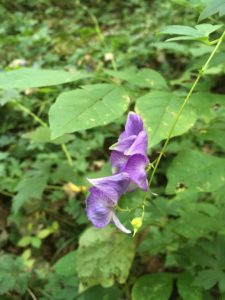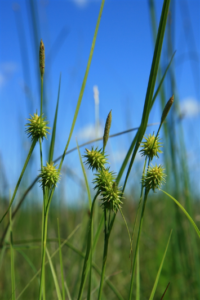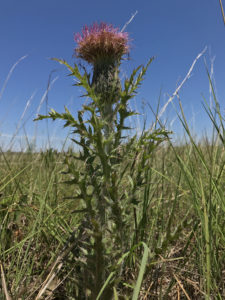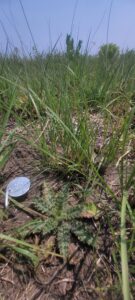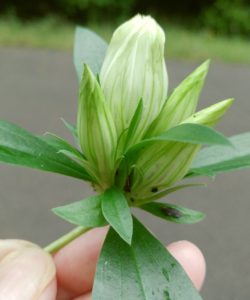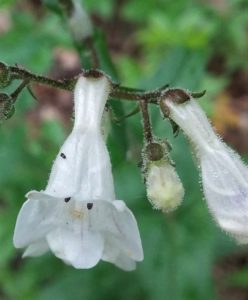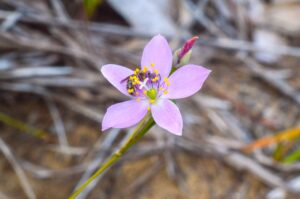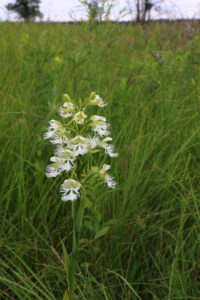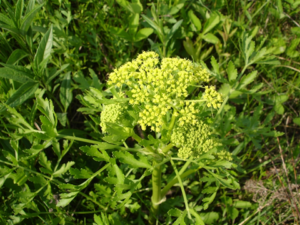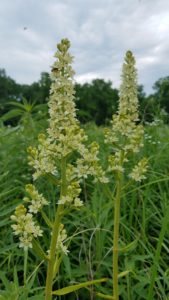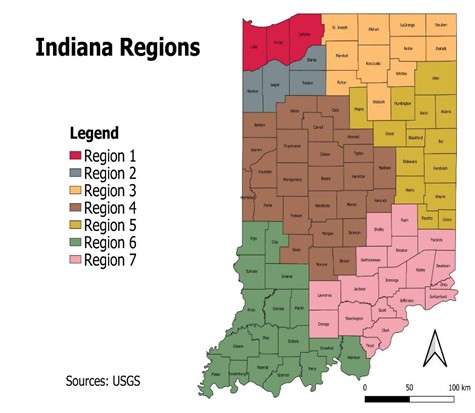The Rare Plant Species Prioritization Committee (Adam Balzer, Lee Casebere, Bob Easter, Michael Homoya, Rich Hull, Scott Namestnik, Stuart Orr, and Victoria Wittig) met and provided INPCA partners with a spreadsheet to rank species by perceived conservation need (high, medium, low), with write-ins allowed. That input was analyzed and the committee met to finalize priorities
Criteria for INPCA Priority Plant Species Selection 2021
- High ranking based on prioritization process
- GRank indicating critically imperiled (G1), imperiled (G2), or vulnerable (G3), or GRank of 4 or 5 but disjunct in our region
- Critically at risk in Indiana
- Different geographical regions covered
- Overall perceived need for conservation by the committee
Become an INPCA Rare Plant Species Team Volunteer
Would you like to help a Species Team with their work? Just email the team lead below for that species.
Note – All members of Species Teams must complete and sign a Confidentiality Form before participating in conservation activities. Completed forms are to be sent to aheikens@franklincollege.edu
Species Progress
Southern Blue Monkshood (Aconitum uncinatum)
Southern blue monkshood, a member of the buttercup family, is found in two counties in southern Indiana. The northern of the two sites is found on a slumped slope which is converting into a flat bench along a dry creek with rich, deeper soil than the surrounding area. Two populations in the southern county are found in similar landscapes but also found on sandstone outcrops as well as thinner limestone soils. Most stems are weak and trailing, often hitchhiking on neighboring plants. Plants can survive in full shade but with significant sunlight thrive and produce flowers and viable seeds.
Efforts to increase the northern population started in 2019 but few seeds were produced. In 2020 hundreds of seeds were collected with 62 germinating. The resulting plants were divided up for planting in spring and fall in the northern population. While the original intent was to grow some plants from northern seed for possible transplantation at the southern location, at that time the only southern population was on unprotected land and not in large numbers. In fall 2021 a large population was found in the southern county over several acres on protected land, thus changing plans.
The long-term plan for this species is to continue observation of the existing and newly planted populations, possibly reintroducing the southern genetics back into older southern sites that may no longer host the species.
Submitted November 2021 by team lead Mike Everidge, meveridge@tnc.org
Kittentails (Besseya bullii)
Kittentails is a species endemic to six Upper Midwestern States: Wisconsin, Minnesota, Iowa, Illinois, Indiana, and Ohio. Besseya bullii is a rare species and considered threatened or endangered in all these states except Ohio, where it is thought to be extirpated. The species occurs infrequently in oak savanna, dry (-mesic) woodland, and dry prairie habitats characterized by very well drained soils typically formed on sand and gravel and open ecosystem structure. Never common to begin with, loss of habitat due to conversion or overgrowth of shrubs and forest canopy has greatly diminished its range. There is some anecdotal evidence from Wisconsin that the species can persist in moderately disturbed habitats; however, prescribed fire or other management methods to maintain an open ecosystem structure appear to be essential to the species’ continuity.
In Indiana, sparse populations of kittentails have been documented from a few sites in 6 counties: Lagrange, Elkhart, St. Joseph, White, Tippecanoe, and Vigo. All of these occurrences except LaGrange County were known at the time Deam (1940) published the Flora of Indiana. The Lagrange County site was identified later. Deam (1940) described these occurrences as “Very local. Usually only one or a few plants are found at a place.”
The LaGrange County site is known to have a robust, albeit isolated, population of kittentails under habitat management. Invasive shrub cover, overstory shading, cool-season grass competition has been reduced. Prescribed fire is used to maintain an open woodland forest floor. Since 2011, monitoring has shown an increase in numbers from fewer than 50 plants in 2011 to over 500 in 2020.
In 2022, INPCA will survey extant and historical kittentail locations. Identifying and assessing other kittentail sites, extant and historical, is the first step in recovering and protecting this species in Indiana.
Submitted January 2022 by Nathan Herbert, nherbert@tnc.org.
Green Star Sedge (Carex viridistellata)
Green Star Sedge is a newly recognized sedge species of calcareous wetland habitats in Michigan, Ohio, and Indiana. It is listed as G2G3, indicating uncertainty about the exact status of the species. There are two historical records of the species in Indiana, one in Henry County and one in Wabash County. DNR Nature Preserves is working with partners through the Indiana Plant Conservation Alliance to understand the status of this species.
Submitted January 2022 by team lead Dawn Slack, dawnraschel@gmail.com.
Hill’s Thistle (Cirsium hillii)
Cirsium hillii, Hill’s Thistle, is a state-endangered, globally rare plant species found only in the Midwest. Historically, this species inhabited prairie and savanna communities in the Dune and Swale, Grand Prairie, Kankakee Sands, Wea Plains, and Pigeon River Sands regions of Indiana. Currently there are less than 10 known extant populations in the state, many of which consist of just a few clones. As clonal species that is not capable of self-pollination, Cirsium hillii can only produce seed when pollinated by another genetic individual, limiting a small population’s ability to produce seed.
Since 2014, The Nature Conservancy (TNC), NICHES, and the IDNR Division of Nature Preserves have been working on projects to increase the viability of Cirsium hillii populations in Indiana. These entities, under the auspices of the Indiana Plant Conservation Alliance, intend to collaborate to augment the genetic diversity of extant C. hillii populations and to reintroduce the species to appropriate conservation lands within its historic range. The ultimate goal is to create enough genetically diverse populations on managed conservation lands to secure the species’ future in the state, and to provide a template that can be used range-wide for conservation action.
Submitted January 2022 by team lead Stuart Orr, sorr@tnc.org.
Striped Gentian (Gentiana villosa)
First recorded in Indiana by Stella Deam, striped gentian is a delicate resident of dry, open woodlands whose range finds its northern extreme in Harrison County. It has never abundant in the state, with only three known locations and just one verified as extant but not reproductive in 2021. There are two historical populations that have not been found in the recent past.
Field surveys of the three known sites were performed in 2020 and 2021 with more planned for 2022. Habitat information from collections in Indiana, Ohio, Kentucky, and Tennessee was compiled and will guide efforts to discover new populations. Recent collections come mostly from disturbed areas like powerline rights-of-way and roadsides. Likely habitat within its small range, as well as historic locations, will be the priority for field surveys in 2022.
Submitted December 2021 by team lead Wyatt Williams, wwilliams@dnr.in.gov.
Deam’s Penstemon (Penstemon deamii)
Deam’s penstemon, a member of the plantain family, is endemic to Indiana, occurring nowhere else. It is named after its discoverer, Charles Deam, Indiana’s first state forester and author of the Flora of Indiana. Efforts are ongoing to establish the current number of plants/populations and habitats in southern IN.
Submitted November 2021 by previous team lead Mike Everidge. Current team lead is Jason Larson, jlarson@dnr.IN.gov.
Prairie Fameflower (Phemeranthus rugospermus)
Prairie Fameflower (Phemeranthus rugospermus) is a small perennial in the Purslane family. It occurs in scattered counties throughout the central US, but is considered rare, threatened, or endangered in every state across its range. The species grows in open, sandy, disturbance-dependent habitats. Its pink flowers bloom for just a few hours in the late afternoon.
In Indiana, Prairie Fameflower is restricted to sandy habitats in the northwest corner of the state, in both the lakefront dune region and the Kankakee region. Records exist from Lake, Porter, Newton, and Jasper counties. Many historic records are from habitat that has been lost to development or succession, but more work is needed to survey old records to confirm current status.
The fame flower team is assessing known populations to build upon a history of monitoring, working with researchers to understand the pollination dynamics, plant nursery raised local genotype plugs to bolster existing populations and working to implement management in areas where the species occurs.
Submitted March 2023, updated December 2025 by team lead Gus Nyberg, nyberggus@gmail.com
Mountain Phlox (Phlox ovata)
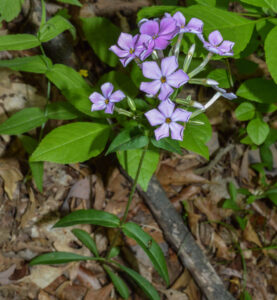
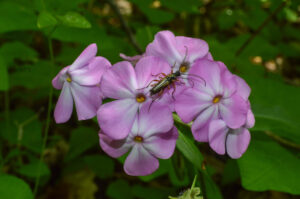
Mountain phlox is a member of the Polemoniaceae family that is characterized by showy pink to purple flowers. Its primary distribution is in the Appalachian Mountains and the Piedmont of Virginia and North Carolina but with disjunct populations in northeast Indiana, northwest Ohio, and southeast Michigan. It is currently known from only Allen County in Indiana, with historical records in Whitley County. In Indiana it appears to favor dry to mesic oak woodlands along north-facing slopes or ravines.
The primary goals for the mountain phlox team in the first year will be documentation and monitoring of known populations, their habitats, and associate species; searching for unknown populations near existing occurrences; and investigating historical records and reference for additional locations that may harbor the species. The information gathered will inform any conservation efforts that may be necessary for the species.
Submitted April 2025 by team lead Ryan Mendenhall, ryan.mendenhall@stantec.com
Eastern Prairie Fringed Orchid (Platanthera leucophaea)
The eastern prairie fringed orchid is a plant of wet open habitats in the eastern United States. It is listed as threatened under the Endangered Species Act based upon declines across its range. There is one extant population remaining in Indiana. DNR Nature Preserves has been working with the USFWS to understand, augment, and expand this vulnerable species.
Submitted January 2022 by team lead Tom Swinford, swinfordthomas1@gmail.com.
Prairie Parsley (Polytaenia nuttallii)
Prairie parsley is a member of the Apiaceae family native to the central and midwestern United States. P. nuttallii is a biennial or short-lived perennial, living as a basal rosette of deeply divided pinnate leaves for one to four years before producing an inflorescence up to one meter tall with several slightly rounded umbels of flowers. Historically known from 17 states, this conservative prairie endemic is now threatened or extirpated from much of its northern and eastern range. Indiana lies on the northeastern edge of the plant’s range, with only eleven known occurrences. The INPCA Region 1 Team is in the process of searching for remnant populations of this threatened plant from previously known sites, and from other appropriate dry prairie remnants as well.
Submitted June 2023 by team lead Doug Botka, dbotka@heinzetrust.org.
Virginia Bunchflower (Veratrum virginicum)
Virginia bunchflower is a member of the lily family and is found in consistently rich, moist soil conditions that are in full sun or partially shaded. The thick stems can reach 5′ with a panicle of fragrant whitish flowers in June and July. In 1940, Charles Deam mapped the species to 5 counties in Indiana, and in 2021, the species is naturally known from just 2 sites, one near Muncie and the other near Monticello. Both sites are unprotected remnant natural areas.
In 2021, the Veratrum team collected seed from the remnants and kept the genetics separate. The seed will be used to grow out the plants in a greenhouse. Plugs produced will be used for outplanting at protected lands that have appropriate habitat conditions in the spring of 2022. Muncie genetics will be used for restoration in eastern Indiana, and Monticello genetics will be used for western Indiana projects.
The 10 year goal for the species is to have 6 stable wild locations in Indiana on protected land, 3 in the east and 3 in the west, that average at least 20+ blooms annually.
Submitted October 2021 by previous team lead Gus Nyberg. Team lead is now Crystal DeBoer. crystal.deboer@stantec.com.
Ragged Goldenrod (Solidago squarrosa)
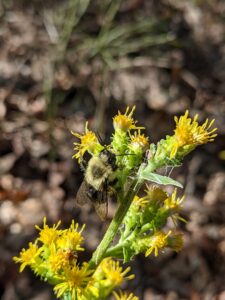
Ragged goldenrod is a member of the Aster family native to the eastern United States and southeastern Canada. The plant’s recurved phyllaries are a distinctive feature that can be used to distinguish it from almost other goldenrods found in the state that have appressed phyllaries. Indiana exists on the far southwestern extent of this plant’s range, and all known populations in the state occur within a small section of Clark State Forest in Clark County.
Seedlings grown from seeds taken from our Indiana plants were planted in 2019 and 2020 to boost the total population out of the single digits and to help promote on-site reproduction. Multiple years in a row of late season droughts, as well as insect herbivory, have had a negative effect on the population of this plant, and their numbers have been slowly declining since direct seedling care has ceased. The team will continue to monitor the population levels of this plant, and will evaluate what our next steps should be.
Submitted June 2025 by team lead Peyton Phelps, rphelps1@dnr.in.gov.
Baxter’s Violet (Viola baxteri)
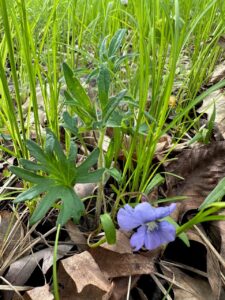

Baxter’s violet is a member of the very large and diverse violet family. It is characterized by deeply biternately lobed and moderate to densely hairy leaves. In Indiana, it is currently known only from Allen County and Jay County. The habitats at the known sites are prairie-like openings surrounded by associated swamp/mesic forest. Indiana is currently the western most occurrence of this species.
Current perceived risks for this species include habitat destruction in the quickly developing Allen County. Canopy closure and competition from the midstory have also diminished populations. Another unique risk is hybridization with other violet species such as Viola palmata and Viola sororia.
The team will be working on stabilizing populations through habitat management. We will also be characterizing the species and their hybrids. Since there are only a few sites, we will also be working to establish a characteristic habitat which will help in the search for additional populations.
Submitted June 2024 by team lead Kelly Wheat, violabaxteri@kwheat.com

